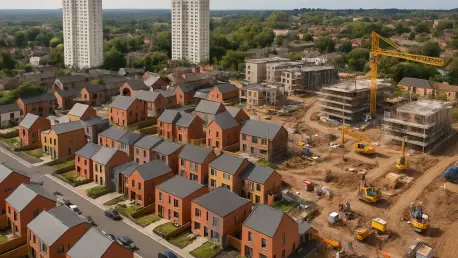In the heart of south Birmingham, a staggering £1 billion regeneration plan for the Druids Heath estate has captured the attention of urban developers, policymakers, and housing market analysts alike, promising to deliver 3,500 new homes over the next decade. This project stands as one of the most ambitious urban renewal initiatives in the region, addressing not just housing shortages but also the broader need for sustainable, community-focused neighborhoods. As Birmingham grapples with a target of 51,100 new homes by 2031, the stakes are high. This analysis explores the market dynamics, trends, and projections surrounding the Druids Heath regeneration, evaluating its potential to reshape the local housing sector and set a precedent for estate revitalization across the UK. The focus is on understanding how this initiative aligns with current demands and what it signals for future investment opportunities.
Market Trends and Data Driving the Druids Heath Project
Housing Demand and Affordability as Core Drivers
The Birmingham housing market is under immense pressure, with demand far outstripping supply, particularly for affordable units. The Druids Heath regeneration plan directly tackles this gap by committing to 51% affordable housing—approximately 1,785 of the 3,500 planned homes—with 400 social rent units prioritized in the initial phase. This aligns with city-wide goals to address systemic shortages, as affordability remains a critical barrier for many residents. Market data indicates that Birmingham’s rental and purchase prices have risen steadily over recent years, pushing lower-income families to the margins. The emphasis on mixed-tenure housing in this project reflects a growing trend in the UK real estate sector, where balancing social and private housing is seen as a pathway to stable, inclusive communities.
Infrastructure Investment and Community Impact
Beyond bricks and mortar, the regeneration plan integrates substantial infrastructure upgrades, a move that mirrors emerging market preferences for holistic urban development. A new local high street, sports facilities, community centers, and expansive green spaces are designed to enhance livability and connectivity. Improved transport links and pedestrian-friendly streets aim to reduce the estate’s historical isolation, a factor that has long depressed property values in the area. Analysis of similar projects, such as London’s Elephant and Castle redevelopment, shows that such community-focused investments can boost local economies by up to 15% over a decade through increased foot traffic and business activity. For investors, this signals potential for long-term value appreciation in Druids Heath, though funding consistency for non-housing elements remains a risk to monitor.
Sustainability as a Market Differentiator
Sustainability is increasingly a key consideration in the real estate and construction markets, and the Druids Heath project positions itself at the forefront of this trend. Energy-efficient designs, low-carbon materials, and biodiversity-focused landscaping are embedded in the masterplan, appealing to environmentally conscious buyers and tenants—a growing demographic in urban markets. Partnerships with developers like Lovell and funding bodies such as Homes England ensure adherence to high-quality standards, with full financial agreements expected by spring 2026. Market forecasts suggest that properties with green credentials can command premiums of 5-10% in urban areas, providing a competitive edge. However, construction cost inflation and regional disparities in material availability could challenge the scalability of these sustainable practices.
Projections and Future Market Implications
Short-Term Growth in Construction and Employment
Looking ahead, the Druids Heath regeneration is poised to stimulate significant short-term activity in the construction sector. The phased approach, prioritizing affordable housing and early infrastructure delivery, will likely generate demand for local labor, demolition services, and remediation work. Projections estimate hundreds of jobs and apprenticeships over the next few years, aligning with broader UK trends where urban renewal projects contribute 2-3% to regional GDP during active phases. For construction firms and suppliers, this presents immediate opportunities, though competition for skilled workers in the Midlands could drive up costs if not managed through local hiring initiatives.
Long-Term Shifts in Property Values and Demographics
Over the next decade, the completion of 3,500 homes and enhanced amenities is expected to transform Druids Heath into a more desirable residential hub, potentially uplifting property values by 20-30% compared to current levels, based on historical data from comparable estate regenerations. The influx of mixed-tenure housing is likely to diversify the area’s demographic profile, attracting young professionals and families alongside existing residents. Market analysts anticipate that improved transport links will further integrate the estate into Birmingham’s economic fabric, making it a viable option for commuters. However, gentrification risks loom, necessitating careful policy oversight to ensure affordability targets are not eroded over time.
Influence on Regional Urban Renewal Strategies
The broader implication of this project lies in its potential to shape regional and national approaches to estate regeneration. As urban markets increasingly prioritize community cohesion and environmental standards, Druids Heath could become a benchmark for future developments. Forecasts suggest that successful execution—particularly in resident engagement, where 68% have already voiced support—may encourage other UK cities to adopt similar models, potentially unlocking billions in public-private investment. Policy shifts, such as increased government backing for social housing between 2025 and 2031, could amplify this trend. The challenge will be adapting to economic fluctuations, but the project’s emphasis on phased delivery offers a buffer against unforeseen disruptions.
Reflecting on Strategic Pathways Forward
Looking back, the market analysis of the Druids Heath regeneration reveals a multifaceted opportunity that intertwines housing solutions with economic and social revitalization. The project’s alignment with affordability needs, infrastructure development, and sustainability trends positions it as a pivotal case study in urban renewal. For stakeholders, the insights gleaned underscore the importance of maintaining a balance between immediate economic gains and long-term community benefits. Moving forward, strategic recommendations include prioritizing transparent resident communication to sustain support, leveraging local employment to maximize economic impact, and closely monitoring cost pressures to protect sustainability goals. Additionally, developers and policymakers are encouraged to explore innovative financing models to ensure non-housing amenities are not sidelined. This regeneration effort, with its comprehensive vision, offers a roadmap for transforming neglected estates into thriving market hubs, paving the way for sustained investment and growth across Birmingham and beyond.









